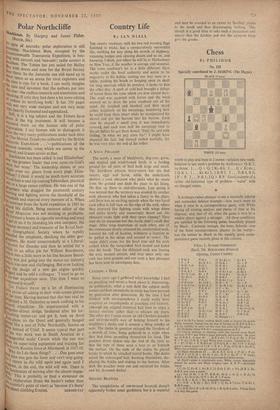Chess
By PHILIDOR
No. 128
Specially contributed by J. HARING (The HaguC) at.AcK (5 men)
WHITE (10 men)
WHITE to play and mate in 2 moves solution next week. Solution to last week's problem by Aizikowicz: Q-K 7, no threat. 1,,,Q X Q; 2 Kt-B 6. 1 Q x Kt etc.; 2 Q-K 1. 1 ... Kt-Kt 3; 2 I3-B 3. 1 . P-B 4, B 3; 2PxP. I...P-R5; 2 Q x R P. Good example of a rather old-fashioned type of problem —'waiter' with no changed mates. , It is always rather pleasant to see a reputedly inferior and outmoded defence triumph—how much more so when it wins in a correspondence game, with White having all existing analysis and plenty of time at his disposal; and, best of all, when the game is won by a weaker player against a stronger. All these conditions are satisfied in the following game, beautifully played , by Black. Curiously enough, the loser, Schmid—one of the finest correspondence players in the world— was the winner as Black in the equally good corre- spondence game recently given in this column.
While, L. SCHMID (Germany) Black, DR. BERGRASSER (France) Opening, Centre Counter
I P-K 4 P-Q 4 22 Kt-Kt 5( ) 2 PxP Kt-K 133 23 Q-K I 3 B-Kt 5 ch 11-Q 2 24 K-R I 4 B-B 4 B-Kr 5 25 R-B 3 5 P-K LI 3 13-13 4 26 Li-Kt 4 ch 6 Kt-K 2 (a) Kt x P 27 R-Q B 1 7 Kt-Kt 3 B-Kr 3 . 28 13-11 5
8 0-0 1"-:K 3 29 R-Kt 1 ( g ) 9 P-B 4 (b) Kt-Q B 3 30 R x P 10 P-Q 4? (c) Q Kt-K 2! 31 Kt-R 3 (h)
11 13-Kt 3 P-K R 4! 32 I' x Kt 12 Q-K 2 P--R5 33 Q-K 4 1 1 ) ' 13 Kt-K4 B x Kt 34 P x K 14 Q x B Kt-B 4 35 K-Kt I
15 P-B 3 (d) B-K 2 36 K x R
16 Kt-Q 2 P-13 41 • 37 K-Kt 1 17 Kt-B3 P x P 38 K-B 1 18 13-R 4 eh K-B 1 ' 39 K-K I
19 P x P Q-Kt 3 (e) 40 LI x Q
20 B-Q 2 R-Q 1 41 R-I3 I
21 13-13 3 B-Q 3 42 Resigns (1 )
(a) 6 Kt-B 3 is better, making Black work to recover his pawn: White, however, already has tire idea of forcing his K B P to /3 5— it is his inability to carry out this plan that costs him the game. (b) Probably better 9 P-Q 4, retaining pawn on 13 3.
(e) Critical moment in opening; after this natural move Black prevents P-B 5 and White's game gradually deteriorates. He must try 10 P-B 5. If now 10 . . . B-I3 4 ch?; I I P-Q 41, Kr x P (or B x P ch); 12 K-R I! and White wins a piece. Therefore 10 . . P x Pt; I I Kt x P,4 ch;12 P-Q 4, B x Kt; 13P B and game is about equal—if 13.R x B, B x 1' cli; 14 K-R I, Kt-B 3; White has probably not got enough for pawn. (d) Black threatened 1.5 . . Kt-K B 3; 16 Q x P, Q • x P ch; 17 12-13 2 (17 K-R1,-Kt 6 chi; 18 P x Kt, P x P mate), Q-Q 8 eh; 18 Ft,-El I, A-B 4 ch and mates in 2 more moves.
(e) Black's game is positionally won; White cannot adequately defend his pawns and Black knights—and K R P —dominate board.
( /.) Or 22 Kt-K 5. Kt-B 3; 23 Q-Q 3. Kt x P!; 24 B x Kt, B-13 4, and wins a pawn.
(g) Not 29 Kt x K P?, B-R 4!; 30 Q x B, Q x R ch; B-Kt 1, Kt-Kt 6 ch; 32 P x Kt, P x P mate.
(1) 31 R x B, Q x Kt; is equally hopeless.
( I ) 33 R x B, Kt x Kt!; 34 R x Q, Kt-B 7 d.elt; 35 K-Kt 1, R-R 8 mate.
(J) 42 R-Kt 4, B x R ch; 43 Q x B, Q-K 6 mate. Fitting finish. to a very fine game.
Kt-13 3 Kt x P Kt-B 4 1SB2 K-Kt 1 Kt-Q 4 Q x P 0-11 3 Kt x P Kt-Kt 6 eh P Kt x Kt R x Pch R-R 8 eh I 0-12. 3 ch Q-R 7 ch P-Kt 7 ch I'-Kt 8-Q ch x 13 eh I3-R 4 ch










































































 Previous page
Previous page